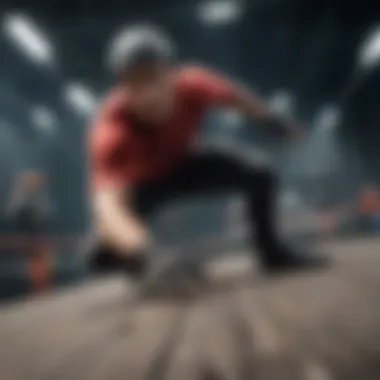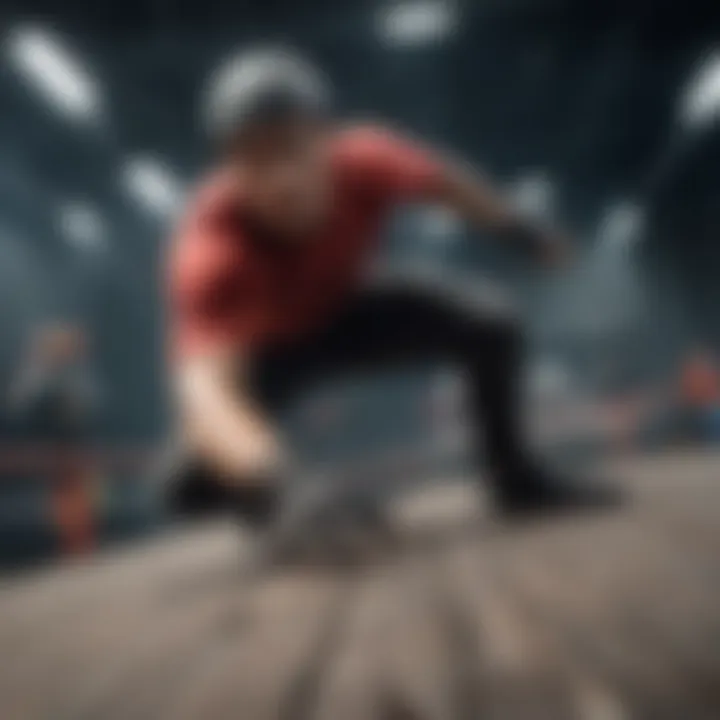Exploring the Fascination with Almost Decks in Extreme Sports


Intro
The allure of extreme sports is undeniable, drawing in enthusiasts from all walks of life. One facet that often captures the attention of both participants and observers is the concept of ‘almost decks.’ These skateboards, favored for their unique construction and design elements, play a significant role in shaping the experiences of athletes within the extreme sports community. Understanding almost decks requires a look into their design, implications for performance, and the deeper meanings they hold.
As we delve into the intricacies of almost decks, we will explore how these boards interact with the skills and techniques of riders. This section serves as a gateway to understanding why almost decks are not just a trend but a pivotal aspect of skateboarding and similar activities.
Techniques and Tips
Skill Development
Enhancing one's skills in extreme sports often begins with the right equipment. Almost decks bring a unique set of advantages that can help riders cultivate their skateboarding techniques. To master the art of balance and tricks, it is crucial for enthusiasts to focus on their stance and body movements. The use of almost decks allows for greater feedback in these areas, as their design tends to enhance stability and control.
Practical Techniques
Here are some practical techniques that can assist beginner and intermediary riders in maximizing the benefits of almost decks:
- Experiment with Stance: Try different foot placements to see what feels most comfortable.
- Focus on Weight Distribution: Understanding where your weight is should help improve control.
- Practice Tricks Gradually: Start with basic maneuvers and gradually work up to more advanced tricks.
Common Mistakes to Avoid
Skateboarding is as much about awareness as it is about skill. Riders using almost decks should be mindful of certain common pitfalls, including:
- Overconfidence in performing tricks without ample practice.
- Neglecting the importance of warm-ups and stretches.
- Failing to consider the terrain type when practicing.
"Understanding equipment can significantly impact a rider's experience. Almost decks symbolize not just a choice of gear but a commitment to the sport."
Gear and Equipment
Essential Gear for Beginners
For those starting their journey in extreme sports, having the right gear is critical. New skaters should prioritize basic protective gear along with their almost deck, such as:
- A well-fitted helmet.
- Knee and elbow pads.
- Quality skate shoes with good grip.
Latest Innovations and Trends
In the ever-evolving world of skateboarding, technology plays a crucial role in shaping new designs. Recent trends indicate an increasing focus on lightweight materials and eco-friendly production methods. These innovations not only cater to performance but also appeal to environmentally conscious athletes.
Reviews and Comparisons
When it comes to selecting the best almost deck, a thorough review process can aid decisions. Comparing features like flexibility, weight, and grip can lead to a more informed choice. Websites such as reddit.com offer community insights that can be invaluable for new riders.
Safety Measures
Essential Safety Gear
Safety cannot be overemphasized in extreme sports. Key pieces of equipment to keep riders safe include:
- Helmets designed for impact resistance.
- Protective pads for joints.
- Brightly colored clothing for visibility.
Best Practices for Safe Participation
Engaging safely in extreme sports requires a combination of strategy and sensible decisions. Riders should avoid crowded spaces while practicing and be aware of their surroundings at all times, including other skaters and potential obstacles.
Injury Prevention and Management
Despite precautions, injuries can occur. It's essential to recognize common injuries associated with skateboarding:
- Sprains and strains.
- Fractures, particularly in wrists and arms.
- Abrasions resulting from falls.
To manage injuries, basic first aid knowledge is necessary. It is wise to consult healthcare professionals for severe injuries and always ensure a proper recovery period before resuming activities.
Spotlights on Extreme Sports
Featured Sport of the Month
This month, our attention turns to freestyle skateboarding. It challenges skaters to push their creativity and technical skills. Athletes often use almost decks to perform grinds and flip tricks, emphasizing individual style.
Profiles of Prominent Athletes


Highlighting inspiring athletes in the sport serves to highlight the connection between equipment and skill. Skaters like Tony Hawk and Nyjah Huston are known for their innovative techniques and dedication to advancing skateboarding, often showcasing how almost decks enhance their performance.
Understanding Almost Decks
The topic of Almost Decks warrants attention within the extreme sports narrative due to their unique attributes and the significant role they play in enhancing the riding experience. Almost Decks are not just a fashion statement or a simple variation in skateboard design; they embody a convergence of innovation, performance optimization, and personal expression. As extreme sports evolve, so do the tools that athletes utilize, making it imperative to understand what differentiates Almost Decks from traditional options.
Fully grasping the concept of Almost Decks opens avenues for riders to better align their gear with their personal style and performance needs. This section surveys key elements such as their structural distinctions, influences from skateboarding culture, and the enhanced capabilities they offer athletes. Such knowledge helps thrill-seekers make informed decisions that can optimize their performance and enjoyment on the board.
Definition of Almost Decks
Almost Decks refer to a specific type of skateboard deck that has been designed with particular characteristics to emphasize versatility and performance. They are often lighter compared to traditional decks and feature various shapes and sizes, adapting to the rider's style. Almost Decks can also possess a slight concave that allows for enhanced maneuverability. In essence, the concept of Almost Decks encompasses all skateboard decks that do not fully conform to traditional manufacturing norms but instead cater to a more specific audience of engaged riders.
Historical Context
The evolution of skateboard decks has been closely linked to the growth of skateboarding culture. Since the 1960s, decks have seen numerous changes in materials and shapes, driven by both technology and rider demand. Almost Decks emerged from this backdrop as a representation of innovation within the sport. Riders sought gear that could support more complex tricks and stunts, leading manufacturers to experiment with designs that deviated from the norm.
The introduction of new materials, such as lighter composites and improved wood laminates, paved the way for Almost Decks to redefine performance expectations. This historical progression highlights how market needs and rider experiences shape product development, ultimately leading to the current fascination with Almost Decks.
Understanding the significance of this evolution provides valuable insight into how equipment influences training and the execution of tricks in skateboarding.
The Evolution of Skateboard Decks
The development of skateboard decks is a critical element in understanding how extreme sports gear has transformed over time. In the world of skateboarding, the deck serves as both the foundation and the primary tool for a rider's performance. Thus, learning about the evolution of skateboard decks reveals trends in design and technology that directly influence how skaters engage with their craft. This section will explore how decks have changed from traditional forms to their modern counterparts known as almost decks, as well as the breakthroughs in materials and construction that have emerged during this journey.
From Traditional to Almost Decks
Historically, traditional skateboard decks were often made from wood, primarily maple. The shape of these decks was relatively straightforward after the flat, nose, and tail designs became standardized in the 1980s. These designs focused on basic functionality and durability but lacked customization. As skateboarding evolved, so did the need for decks that could accommodate more advanced tricks and personal preferences.
Almost decks began to emerge as a response to changing rider needs. They were designed with different width, length, and concave options, allowing riders more control and versatility. The term "almost decks" often refers to decks that leverage innovative shapes and construction methods to enhance performance.
This shift represents not just a change in physical characteristics but an entire philosophy shift in skateboarding where individuality and personalization became paramount. Riders began to express themselves through the specific features of their decks, moving away from a one-size-fits-all mindset.
In summary, the transition from traditional decks to almost decks signifies a broader trend in extreme sports towards customization, responsiveness, and performance enhancement.
Key Innovations in Deck Technology
As we analyze the evolution of skateboard decks, it is essential to highlight several key innovations that have defined modern almost decks. These advancements include:
- Material Development: Modern almost decks often utilize advanced materials that improve strength and reduce weight. For example, some decks incorporate carbon fiber or fiberglass layers, which offer enhanced durability without compromising performance.
- Manufacturing Techniques: Techniques such as cold pressing have become prevalent. This method allows for better lamination of the skateboard layers, resulting in a more consistent product.
- Shape and Concave Variations: Innovations have led to various shapes and concave profiles that cater to different riding styles. For instance, deeper concaves allow for better foot locking during tricks, which can dramatically improve maneuverability and stability.
"Innovation in deck technology is not just about materials; it's about listening to the needs of riders and enabling them to push their limits."
The evolution of skateboard deck technology has made it possible for riders to evolve in their abilities, creating a direct link between the equipment and the extreme sports culture. Today, almost decks represent the pinnacle of this evolution, offering extreme sports enthusiasts new horizons to explore.
The Anatomy of an Almost Deck
The anatomy of an almost deck is crucial to understanding its role in extreme sports, particularly skateboarding. The elements that make up an almost deck contribute significantly to the performance and enjoyment of the rider. Knowledge about the materials, size, and shape variations can aid enthusiasts in making informed decisions. Delving into these aspects not only highlights the technical features but also illustrates how these factors influence user experience.
Materials Used
The construction of an almost deck is primarily influenced by the materials employed. Commonly, these decks are made from a variety of woods, plastics, and composite materials. The most prevalent material is maple wood, renowned for its strength and flexibility. This wood is layered to enhance durability and responsiveness during tricks.
Other manufacturers experiment with materials such as bamboo and birch, which can offer lighter alternatives without sacrificing performance. Additionally, carbon fiber and fiberglass are incorporated in some high-end models. Each material provides distinct characteristics affecting the weight, stiffness, and feel of the deck. The choice of material can greatly influence rider performance, particularly in high-impact movements.
Size and Shape Variations
Size and shape are paramount in defining how an almost deck performs. Generally, the width can range from 7.5 inches to 8.5 inches, catering to different styles of skating. Wider decks offer increased stability, essential for tricks and landings, while narrower decks may enhance maneuverability.
Shape variations also play a significant role. Traditional popsicle shapes remain a favorite among street skaters as they facilitate easy turning and flip tricks. Meanwhile, cruiser shapes are preferred for their relaxed geometry, ideal for casual riding. These shape variations cater to the diverse tastes and preferences among the skating community. Thus, the anatomy of an almost deck is not just about physical attributes; it reflects the evolving nature of skateboarding itself, paving the way for personal adaptation and innovation.
"Choosing an almost deck is like selecting an extension of oneself; the right materials and shape can significantly enhance the skating experience."
Conclusively, understanding the anatomy of an almost deck enables skaters to optimize their performance. The materials, sizes, and shapes are not only technical specifications but are integral to fostering creativity and skill in extreme sports.
Performance Aspects of Almost Decks
The performance characteristics of almost decks critically shape how riders interact with their environment. These specialized decks offer distinct advantages that cater to the nuanced demands of extreme sports. Their design influences not just the rider's technique, but also the overall experience on the board. To truly understand almost decks, one must delve into two main aspects: their effects on riding dynamics and their impact on maneuverability and tricks.
Effects on Riding Dynamics


Almost decks fundamentally alter riding dynamics. Their construction, typically lighter and more rigid than traditional skateboard decks, allows for enhanced feedback and responsiveness. When a rider performs tricks or glides over surfaces, the interaction between the wheels and the deck is vital.
- Control and Stability: The materials used in almost decks contribute to how they handle energy transfer. A well-balanced board can provide stability at high speeds while still allowing for quick adjustments when needed.
- Weight Distribution: Many riders find that an almost deck can affect weight distribution. Optimally designed decks encourage more natural movement, allowing riders to initiate tricks or adjust stances without excessive effort.
The construction and unique features of almost decks also affect the way energy is conserved and redirected, which is crucial for jump and trick execution. As riders become accustomed to these dynamics, they often report an increased sense of connection to the board.
Influence on Maneuverability and Tricks
The maneuverability of almost decks is another defining factor in their appeal. Riders appreciate a board that not only supports their weight but allows them to navigate tight spaces and perform intricate tricks with relative ease.
- Shape Variations: Different shape and design choices, including tail and nose configurations, provide diverse options for executing tricks. Some riders prefer decks with pronounced curves, enhancing their capability for specific maneuvers.
- Real-Time Adjustments: Riders using almost decks often note that the boards respond dynamically to body movements, supporting quicker transitions between tricks. The ability to shift weight and make real-time adjustments plays a significant role in a rider's confidence, particularly in high-stakes environments.
An almost deck’s ability to facilitate better tricks opens avenues for creativity in riding. As these boards evolve, they continue to inspire skating techniques and styles, pushing the boundaries of what is possible.
"An almost deck changes not just how you ride but what you think is possible on a skateboard."
Choosing the Right Almost Deck
Selecting the right almost deck is a pivotal aspect for individuals engaging in extreme sports, particularly skateboarding. With a variety of designs available, understanding one's personal preferences and needs is essential for enhancing performance and enjoyment. An almost deck can significantly influence riding experience, and ensuring the right fit can lead to better tricks, smoother rides, and increased confidence in the sport.
When considering an almost deck, one must evaluate various factors, including material composition, shape, and size. Different materials offer unique durability and flex, impacting how the deck responds to rider input. Furthermore, deck shape plays a role in maneuverability and stability. Size is also crucial, as a deck that is too long or too short can hinder a rider's ability to perform effectively.
Factors to Consider
- Riding Style: Riders should first reflect on their preferred style. For instance, street skating often requires a different deck than vert skating. Understanding your primary practice will inform many of the decisions that follow.
- Deck Material: Almost decks are typically made from various materials, including maple and bamboo. Maple is known for its toughness but offers less flex. Bamboo, on the other hand, may provide a more forgiving ride, appealing to those who favor smooth transitions over rigidity.
- Size and Width: The dimensions of the deck matter significantly. Wider decks can provide a better feel for those doing tricks, while narrower decks often facilitate easier flipping and board rotation during jumps. It's essential to find the right balance that works for specific maneuvers.
- Concave Type: The concave shape affects how it feels underfoot. A deeper concave is beneficial for grip and control during tricks, while a mellow concave can be more comfortable for cruising.
- Budget: Almost decks come at various price points. Riders should determine their budget and find options that align with their performance needs without overspending.
Tips for Personalization
Personalizing an almost deck can elevate the rider's connection with their board. Here are some strategies to tailor an almost deck to individual preferences:
- Artistic Expression: Custom graphics allow riders to express their personality. Many companies offer customizable options, or riders can even create their unique designs.
- Grip Tape Selection: Choosing the right grip tape is critical. A good grip tape enhances control while riding. Options come with different textures and patterns, differing in stickiness and feel.
- Choosing Hardware: The type of trucks and wheels attached can vastly change the deck's performance. Different hardness levels in wheels can affect how the deck glides over surfaces, so it is important to choose them carefully based on intended conditions.
- Experimenting with Setup: Riders can try various combinations of components to find what works best. Allow space for experimentation, as this often leads to discovering preferred setups.
- Community Feedback: Engaging with the skateboarding community can provide insights and tips that lead to better personalization of the board. Forums on sites like Reddit can serve as valuable resources.
"A well-chosen deck not only enhances performance but also makes the entire riding experience more satisfying."
Cultural Impact of Almost Decks
The cultural impact of almost decks extends beyond the physical attributes of the product. These decks have become symbols of a lifestyle, shaping the attitudes and perceptions around skateboarding and extreme sports. For many, choosing an almost deck is not just about performance; it reflects alignment with certain values, trends, and identities within the skateboarding community. The significance of almost decks is evident in the ways they influence design, community interaction, and cultural expressions.
Influence on Skateboarding Culture
Almost decks contribute substantially to skateboarding culture, serving as a bridge between innovation and tradition. The choice of deck reflects a rider's personal style, skill level, and even philosophy towards skating. Riders who select these decks often emphasize quality, durability, and the brand's ethos, thus selecting almost decks not just for functionality but also for how they embody the skate culture.
The aesthetic appeal of almost decks resonates with the artistic aspects of skateboarding. Designs often feature intricate artwork, and unique color schemes which allow riders to express their personalities. There are also festivals, events, and competitions where styles manifest vividly. The boards become canvases for both individual expression and community representation.
Communities deeply appreciate innovators in almost decks pushing the boundaries of what is possible on a skateboard. This aspect fosters creativity and encourages skaters of all levels to take risks. The cooperative spirit of basketball courts or skate parks is exacerbated by interesting deck designs that evoke discussions and admiration among peers.
Community and Collaboration
The role of community and collaboration in the realm of almost decks cannot be understated. Skateboarding has always thrived on collective experiences and shared excitement. Many skateboarders actively collaborate with local artists or brands to create unique, limited edition decks. This practice creates a strong bond within the community, promoting joint ventures that enhance the cultural fabric of skateboarding.
These collaborative efforts often result in events where skaters come together to celebrate their shared passion. Polls and discussion forums online, such as those on reddit.com, reflect opinions on new almost deck releases, encouraging engagement and connection among enthusiasts. Such platforms allow skaters to share their thoughts on performance, innovation, and new designs.
In summary, community-driven projects around almost decks foster cooperation and camaraderie. As skaters interact, learn, and experiment together, they expand their skills and continuously evolve the sport. This synergy contributes to a rich tapestry of ideas and traditions that define the skateboarding culture today.
"Skateboarding is not just a sport; it’s a method of self-expression tied to a community of like-minded thrill-seekers."
The Future of Almost Decks
The future of almost decks holds significant importance within the context of extreme sports. As enthusiasts and riders constantly seek performance enhancements and superior experiences, the evolution of these decks is crucial. Understanding emerging trends in design and the potential innovations in materials will elucidate how almost decks may shape skateboarding and other extreme sports in the coming years.
Emerging Trends in Design
Design trends in almost decks reflect a dynamic relationship between aesthetics and functionality. When examining modern designs, several influences emerge:
- Minimalistic Designs: Many riders are opting for simpler designs that focus on essential features. This approach emphasizes the performance aspects over superficial embellishments, creating a more streamlined riding experience.
- Custom Graphics: Customization is significant in extreme sports culture. Riders express individuality through unique graphics and personalized shapes. This trend not only conveys personal identity but also influences performance based on individual preferences.
- Hybrid Decks: Increasingly, skateboarders are experimenting with hybrid designs that incorporate elements from various board types. This trend aims to combine the strengths of different disciplines, enhancing overall versatility and adaptability.
The future designs of almost decks will likely integrate advanced technology to further enhance performance. Features such as built-in sensors to monitor rider movements or smart materials that adjust stiffness based on conditions could bridge the gap between human skill and mechanical enhancement.
Possible Innovations in Materials


Material innovation is pivotal for the advancement of almost decks. The focus on lighter, stronger, and more durable materials leads to significant progress in deck performance. Some promising developments include:
- Advanced Composites: Utilization of materials like carbon fiber or kevlar could result in decks that maintain durability while significantly reducing weight. This change offers riders enhanced speed and agility.
- Eco-Friendly Materials: As sustainability becomes increasingly important in sports, there is a rising interest in eco-friendly alternatives. Materials derived from natural fibers or recycled plastics may emerge, providing required performance while reducing environmental impact.
- Smart Materials: Innovations in smart materials can adapt under different conditions, responding to impacts and rider movements. This technology could lead to a revolutionary approach, drastically changing how riders experience and interact with their decks.
The integration of technological advances and environmentally friendly options ensures a promising future for almost decks. As the extreme sports community continues to evolve, so will the equipment that supports this adrenaline-filled lifestyle.
"The evolution of gear is parallel to the growth of the sport itself, each enhancing the other in a continuous loop of improvement."
The trends and innovations discussed here highlight a pivotal point in the realm of extreme sports. Almost decks will not only influence performance but also redefine the interaction between riders and their equipment, solidifying their status in the sporting community.
User Reviews and Feedback
User reviews and feedback play a significant role in understanding the impact of almost decks in extreme sports, particularly skateboarding. These reviews offer insights directly from the users who experience first-hand the performance, durability, and overall satisfaction of the decks. For both new and seasoned riders, analyzing these opinions can guide decisions on which equipment to invest in.
Feedback serves not just as personal endorsement, but it can also highlight common trends or issues recognized by the community. Users discussing their experiences can reveal important details such as:
- How the design of almost decks influences their riding style.
- Common performance-related aspects, such as grip, flexibility, and weight.
- Any issues regarding balance or control when executing tricks.
Moreover, consideration of these reviews can help manufacturers refine their products based on real-world usage. Retaining a customer base demands a constant evolution of products, and feedback mechanisms can ensure that companies remain tuned to the needs and preferences of riders.
Insights from Professional Riders
Professional riders, due to their experience and exposure to various decks, provide a valuable perspective that goes beyond mere preference. Their feedback can include detailed evaluations of performance metrics, such as how a specific almost deck performs during high-stakes competitions or casual rides.
Many professional skateboarders work closely with brands, helping to develop and refine products. Their reviews often cover:
- The responsiveness of the deck under different conditions, including various terrains.
- The long-term durability of materials used in almost decks.
- What innovations they believe should be prioritized by manufacturers.
These insights can shape the future of deck designs in the skating world.
Community Feedback on Almost Decks
The community feedback segment deepens the understanding of almost decks by examining a broader spectrum of opinions. This involves input from casual riders, skateboarding enthusiasts, and those who participate in forums like Reddit or Facebook groups dedicated to extreme sports.
Community feedback often reveals a variety of uses depending on personal preference, skill level, and intended activities for the deck. Important points that arise from community discussions include:
- Debates regarding aesthetic choices and their significance in expressing individuality.
- Recommendations on specific models fitting various skill levels.
- Shared experiences about where to purchase almost decks for optimal deals.
Engaging with this feedback helps build a cohesive community atmosphere where riders feel supported and informed. By sharing and reflecting on experiences, the user base can collectively elevate their expectations for new products and standards in skateboarding gear.
Safety Considerations
In the world of extreme sports, safety is a critical concern. This is especially true when dealing with almost decks in skateboarding and other similar activities. The allure of speed, agility, and tricks can easily overshadow the need for proper safety measures. Understanding these considerations can help riders minimize risks while enhancing their overall experience.
Understanding Risks with Almost Decks
Almost decks, while designed for performance, come with unique risks. First, the specific design and materials can influence how the board handles during extreme movements. For instance, a lighter deck might enhance agility but may also reduce stability during high-speed tricks. Riders face risks of losing control, which can lead to serious injuries.
Another aspect is the connection between almost decks and the riding surface. Different surfaces can affect grip and balance, creating unpredictability. Wet or uneven surfaces increase the chances of accidents significantly. Riders must also consider their skill levels when using almost decks, as advanced tricks may not be feasible or safe for beginners. Ultimately, awareness of these factors is essential for promoting a safer riding experience.
Tips for Safe Usage
To ensure safe usage of almost decks, riders should adopt certain best practices. Here are some handy tips:
- Wear Protective Gear: Always use helmets, knee pads, and elbow pads. These can significantly reduce injury severity in case of falls.
- Inspect Your Deck: Before each ride, check for any wear and tear. Loose parts or cracks can lead to accidents.
- Choose the Right Environment: Select flat, dry surfaces for practice. Avoid crowded areas or surfaces that can lead to accidents.
- Know Your Limits: It is important to practice tricks that match your skill level. Gradually take on more challenging moves as you gain confidence.
- Stay Educated: Read up on safe riding techniques and consider taking classes if you are a beginner.
"Safety is not just a priority; it's a necessity for every thrill-seeker. Understanding risks and following safety tips can make all the difference between an exhilarating ride and a painful accident."
By adhering to these tips and comprehending the associated risks, users can enjoy almost decks while minimizing dangerous scenarios. Safety should not be an afterthought but rather an integral part of the extreme sports experience.
Closure
Understanding the role of almost decks in extreme sports is crucial for both enthusiasts and athletes. The conclusion synthesizes the key concepts discussed throughout the article, providing clarity on the implications of deck design and performance. By summing up various discussions, the conclusion positions almost decks within the larger context of skateboarding and extreme sports in general. It underlines the significance of choice and performance in enhancing rider experience.
Summarizing the Key Points
- Definition and Importance: Almost decks represent a specific category in the skateboard market with distinct features that cater to various performance needs. They are defined by their unique construction and design that set them apart from traditional decks.
- Historical Context: The development of almost decks has deep roots in the evolution of skateboarding, tracing back to the need for better performance and customization. Understanding this history gives insight into their relevance today.
- Design and Material: Key innovations, such as new materials and shapes, play an essential role in the functionality of almost decks. These materials contribute to the overall weight, durability, and feel during rides.
- Performance Dynamics: The effects of almost decks on riding dynamics and tricks are pivotal. Riders experience enhanced maneuverability, supporting their pursuit of technical stunts.
- Safety Features: The discussion on safety is particularly important. Recognizing the inherent risks of extreme sports, riders must be aware of safety measures pertaining to their equipment.
Final Thoughts on Almost Decks
Almost decks capture the essence of innovation in skateboarding. Their development reflects the ongoing trends in the sport, showing how necessity drives creativity. For riders, the choice of an almost deck is not merely about aesthetics; it impacts their performance on the board. The customization options available allow a unique expression of style and functionality.
As the extreme sports community evolves, so too will the designs and functionalities of almost decks. The continuing dialogue among riders and manufacturers will likely lead to significant advancements in technology and safety. For thrill-seekers, embracing the right equipment is a step toward mastering their craft, thereby enhancing the overall experience of their sport.
"The right deck can make all the difference in performance and enjoyment, shaping the experience of every ride."







